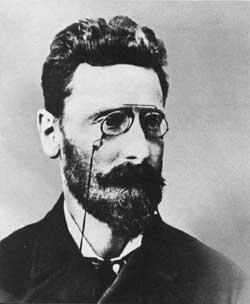|
STATUE OF LIBERTY National Monument Bedloe's Island, New York |
 |
Plan Approved and
Fund Raising Undertaken (continued)
 Joseph Pulitzer. |
JOSEPH PULITZER. Just when the outlook seemed darkest to the American Committee, an efficient champion of the cause appeared. Joseph Pulitzer became owner and editor of the New York World in 1883 and immediately undertook to popularize the campaign for funds to construct the pedestal for the Statue of Liberty. He endeavored to "nationalize" the project, pointing out through his newspaper that the statue was a gift to the whole American people.
Despite his ardent championship of the cause, his efforts to arouse public interest and generosity were not too successful for 2 years. During that time, however, his own prestige grew. He successfully backed the candidacy of Grover Cleveland for President and became famous for his liberal point of view. The World became known as a people's paper.
Meanwhile, other cities displayed an interest in securing the statue. Philadelphia, Boston, San Francisco, and Cleveland offered to pay all the cost of the erection, if the statue were presented to their particular city. A committee from Boston reportedly approached the French Committee. The Baltimore American printed a story that the money for the pedestal could easily be secured in Baltimore, were the statue erected there. Minneapolis and other cities displayed a similar interest.
Then, on March 16, 1885, the World renewed its pedestal fund campaign in grim earnest. Throughout its columns Pulitzer continued to storm at men of wealth who failed to finance the pedestal construction and at the same time criticized the mass of citizens of lesser means who had been content to depend upon the rich to do the job. He assailed the provincial attitude which withheld assistance because the statue was to stand in New York Harbor and called upon every citizen of the country to assist in averting the shame of rejecting what he considered the most generous gesture one nation had ever offered to another. School children were appealed to, and their contributions appreciably aided the fund. The campaign took on the character of a popular crusade. Benefit theatrical performances, sporting events, entertainments, and balls were sponsored. In April, word was received that the statue was being packed for shipment to America, and new impetus was given to the drive. The press of many other cities rallied to the cause. Contributions came from as far away as California, Colorado, Florida, and Louisiana. On May 11, the American Committee, encouraged by the World's success, ordered work resumed on the structure. Thirty-eight of the forty-six courses of masonry were yet to be built.
New enthusiasm was generated by the arrival of the statue at Bedloe's Island on June 19, and by August 11, less than 5 months after it had launched its latest fund drive, the World was able to announce that the pedestal fund had been completed, and the placing of the Statue of Liberty on Bedloe's Island was assured.

|

|
|
Last Modified: Tues, Sep 25 2000 10:00:00 pm PDT |


